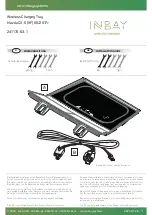
bed as recharge efficiency. Charging losses occur,
for example, due to heat that builds up when the
vehicle is charging or from auxiliary consumers
that are switched on. Further information on
recharge efficiency can be obtained at a qualified
specialist workshop.
Notes on charging the high-voltage battery at a
rapid charging station (mode 4)
&
DANGER Risk of fatal injuries due to dam-
aged components
Connecting the charging cable to a charging
station using a damaged component part
could cause a fire or an electric shock, for
example.
#
For charging stations with a preinstalled
charging cable:
R
Perform a visual check of the charg-
ing station for obvious faults, such as
massive damage to the housing or
charging cable.
#
For charging stations without a preinstal-
led charging cable:
R
For safety reasons, only use charging
cables that have been tested and
approved by the manufacturer for
charging the high-voltage battery in
an electric vehicle.
R
Never use damaged charging cables.
R
Do not extend the charging cable.
R
Do not use adapters.
#
Make sure to observe the safety informa-
tion on the charging station.
&
DANGER Risk of fatal injuries when carry-
ing out maintenance work during the
charging process
During the charging process, the high-voltage
on-board electrical system is under high volt-
age.
#
Do not perform any maintenance work
during the charging process.
Most charging stations must be activated before
the charging process, e.g. using an RFID card or
via Plug & Charge. Observe the on-site operator's
instructions for the charging station and the notes
on Mercedes me Charge (see the vehicle's Digital
Owner's Manual).
The charging cable for the vehicle must not be
longer than 30 m due to the legal requirements in
some countries. This is to prevent the interfer-
ence of signals being received by radio communi-
cation devices in the vehicle or in close proximity
to the charging station. Be aware that parts of the
charging cable may be routed underground. If in
doubt, ask the charging station operator if this is
the case before charging the high-voltage battery.
The amount of energy dispensed for the charging
process, shown by the charging station, may be
higher than the amount of energy actually absor-
bed by the high-voltage battery. This is the result
of different levels of charging losses and is descri-
bed as recharge efficiency. Charging losses occur,
for example, due to heat that builds up when the
vehicle is charging or from auxiliary consumers
that are switched on. Further information on
recharge efficiency can be obtained at a qualified
specialist workshop.
216 Driving and parking
Содержание EQS 350
Страница 9: ...Left hand drive vehicles with central display 6 At a glance Cockpit central display...
Страница 11: ...Left hand drive vehicles with MBUX hyperscreen 8 At a glance Cockpit MBUX Hyperscreen...
Страница 13: ...Standard driver s display 10 At a glance Indicator and warning lamps standard...
Страница 15: ...Driver s display with driver camera 12 At a glance Indicator and warning lamps with driver camera...
Страница 17: ...14 At a glance Overhead control panel...
Страница 19: ...16 At a glance Door operating unit and seat adjustment...
Страница 21: ...18 At a glance Control settings in the rear passenger compartment...
Страница 23: ...20 At a glance Emergencies and breakdowns...
















































